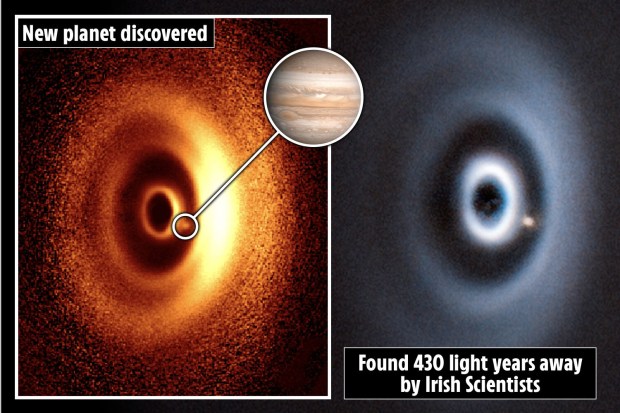Science
Irish Astronomers Discover New Planet WISPIT 2b, 430 Light-Years Away

The discovery of a new planet named WISPIT 2b, located approximately 430 light-years from Earth, marks a significant achievement for a team of Irish astronomers. This remarkable finding was made possible through the collaboration of researchers from the University of Galway, Leiden University, and the University of Arizona. The planet is estimated to be around five million years old and is likely a gas giant comparable in size to Jupiter.
Researchers detected WISPIT 2b at a primitive stage of its formation around a young star that resembles our Sun. The groundbreaking study, recently published in the Astrophysical Journal Letters, highlights the advancements made in the field of exoplanetary research.
Advanced Observations Yield Surprising Results
The detection was accomplished using the European Southern Observatory’s Very Large Telescope (VLT) situated in the Atacama Desert of Chile. Dr. Christian Ginski, a lecturer at the School of Natural Sciences at the University of Galway and the study’s second author, explained the process: “We used really short snapshot observations of many young stars—only a few minutes per object—to determine if we could see a little dot of light next to them that is caused by a planet.”
Interestingly, the researchers initially discovered a striking multi-ringed dust disk rather than the planet itself. Upon seeing this disk, the team quickly sought follow-up observations to investigate further. This finding is only the second confirmed planet detected in such an early evolutionary stage around a young star similar to our Sun, following a similar discovery in 2018.
WISPIT 2b was captured in near-infrared light, a method akin to using night-vision goggles, as it continues to radiate heat from its formative phase. The team produced a clear image of the young proto-planet, confirming its orbit around its host star. The planet is still in the process of accumulating gas, which is vital for the development of its atmosphere.
A Promising Step in Planetary Research
The dust and gas-rich disks surrounding young stars serve as the cradles for planetary formation. These disks can display various structures, including rings and spiral arms, which researchers believe relate to the planets forming within them. The disk surrounding WISPIT 2b has a radius of 380 astronomical units, roughly 380 times the distance from Earth to the Sun.
The study was led by Richelle van Capelleveen, an early-career PhD student at Leiden University, alongside a graduate student team from the University of Galway. Van Capelleveen expressed her excitement about the discovery: “It was an amazing experience—we were incredibly lucky.”
PhD student Chloe Lawlor from the University of Galway highlighted the significance of WISPIT 2b in understanding current planet formation models. She remarked, “I feel incredibly fortunate to be involved in such an exciting and potentially career-defining discovery.”
Jake Byrne, an MSc student at the same university, shared his disbelief when he first saw the image of the planet. He stated, “It’s a big one—that’s sure to spark discussion within the research community and advance our understanding of planet formation.” Another MSc student, Dan McLachlan, reflected on the experience, noting the exceptional opportunity provided to him by Dr. Ginski and the University of Galway’s physics department.
The discovery of WISPIT 2b not only enriches our understanding of planetary formation but also emphasizes the collaborative efforts of international research teams. As astronomers continue to explore the cosmos, findings like these pave the way for new insights into the origins and development of planets in our universe.
-

 Top Stories2 months ago
Top Stories2 months agoTributes Surge for 9-Year-Old Leon Briody After Cancer Battle
-

 Entertainment3 months ago
Entertainment3 months agoAimee Osbourne Joins Family for Emotional Tribute to Ozzy
-

 Politics3 months ago
Politics3 months agoDanny Healy-Rae Considers Complaint After Altercation with Garda
-

 Top Stories3 months ago
Top Stories3 months agoIreland Enjoys Summer Heat as Hurricane Erin Approaches Atlantic
-

 World4 months ago
World4 months agoHawaii Commemorates 80 Years Since Hiroshima Bombing with Ceremony
-

 Top Stories2 months ago
Top Stories2 months agoNewcastle West Woman Patricia Foley Found Safe After Urgent Search
-

 Top Stories4 months ago
Top Stories4 months agoFianna Fáil TDs Urgently Consider Maire Geoghegan-Quinn for Presidency
-

 World4 months ago
World4 months agoGaza Aid Distribution Tragedy: 20 Killed Amid Ongoing Violence
-

 World4 months ago
World4 months agoCouple Convicted of Murdering Two-Year-Old Grandson in Wales
-

 Top Stories3 months ago
Top Stories3 months agoClimbing Errigal: A Must-Do Summer Adventure in Donegal
-

 World4 months ago
World4 months agoAristocrat Constance Marten and Partner Convicted of Infant Murder
-

 Top Stories3 months ago
Top Stories3 months agoHike Donegal’s Errigal Mountain NOW for Unforgettable Summer Views









